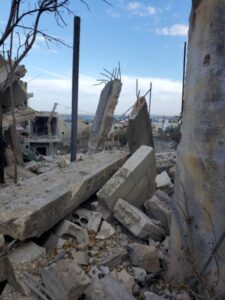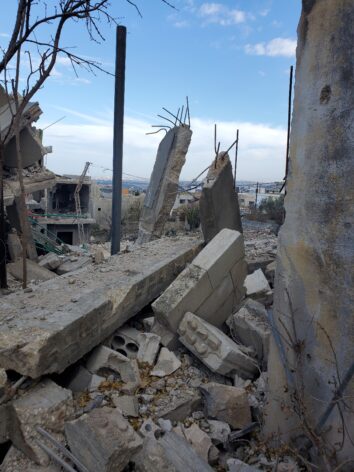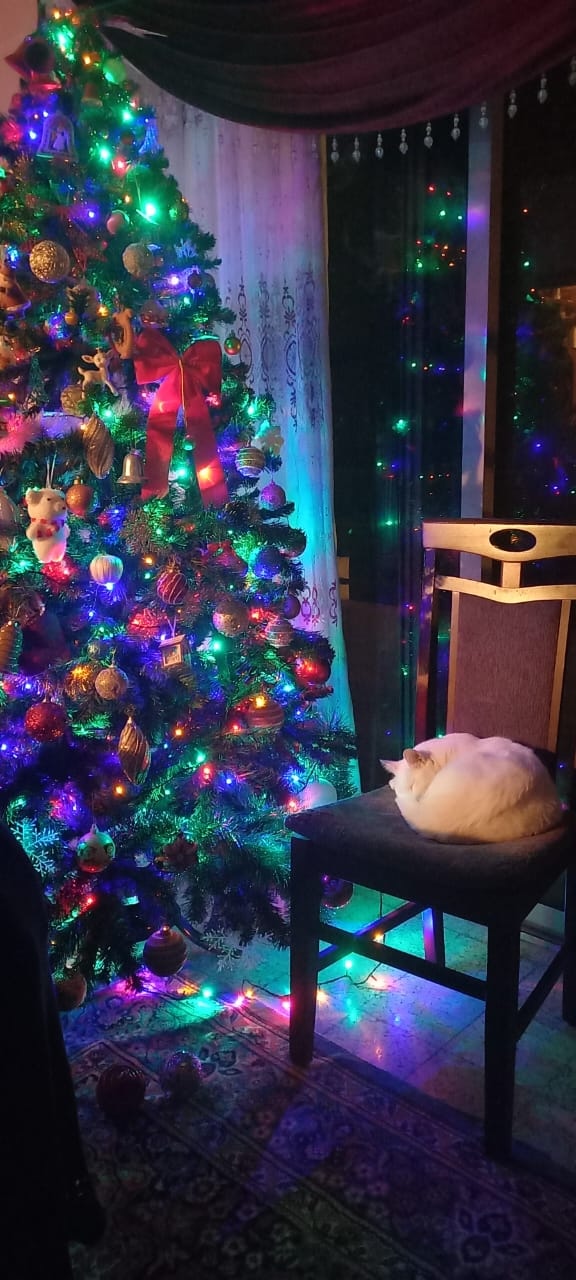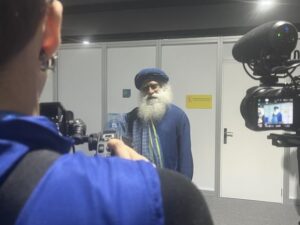
Armed Conflicts, Civil Society, COP29 Blog, Disaster Management, Editors’ Choice, Featured, Headlines, Human Rights, Humanitarian Emergencies, Middle East & North Africa, TerraViva United Nations

Morning after an Israeli attack in Tyre, Lebanon. Credit: Nour
– “Special, targeted operations in southern Lebanon,” a phrase that has echoed repeatedly over the past two years in Israeli Defence Force (IDF) statements. But behind these clinical military terms lies a human cost that statistics cannot capture.
The residents of southern Lebanon—mothers, fathers, children, and elders—are the ones who face the daily reality of displacement, loss, and uncertainty. Their homes become coordinates on military maps; their neighborhoods, theaters of “operations.” Yet their stories of endurance, grief, and quiet acts of resilience rarely reach beyond the headlines.
Through interviews with residents of “Jnoub,” we examine how communities are navigating displacement, processing communal loss, and finding ways to grieve while continuing to live. These are voices from a region too often reduced to geopolitical analysis, voices that reveal the profound human dimension of conflict.
“Ironically, my workplace is close to my old house’s rubble. I see it, as well as the zone where my pet died, on a daily basis. I haven’t grieved as I should… haven’t cried as much as I should have.
“I hate the sound of phone calls, especially the landlines and my father’s good old Blackberry phone, as they remind me of the time we received the threat and people were calling to warn us,” said Sarah Soueidan when asked about her daily routine after her home was destroyed.
Having both her residential house and her family’s house bombed by the Israeli Defence Forces, she and her family had to move repeatedly throughout the past two years. Her hometown, Yater, located in South Lebanon, was directly affected by the war, leaving nothing but old memories and rubble.
The night they had to flee their house in Southern Beirut, Sara and her family woke up to a series of calls while listening to the sounds of ‘warning shots’ on the streets. These shootings were made to help draw attention to residents who did not receive the warning to leave their houses and find shelter before the attack.
As it was only 10 am, they had to act fast, so she and her mother left the house first to see what was going on and then realized that their building would be hit. Sarah had to go back home to warn her father and siblings. Since there was not enough time, and her father needed assistance in movement, they had to pick him up and leave the house with as few objects as possible.
They made sure to put Halloum (Sarah’s cat) in his cage, but due to the rush and many people in the house trying to help, Halloum got scared and jumped out of his cage. Sara and her siblings tried to look for him before leaving, but there was no more time; people were dragging them out of the house. On that day, Sarah took his toys and food, hoping to find him again, but she never did. The Israeli attack on Sarah’s house in Southern Beirut reduced it to rubble.
Sarah and her family had nowhere to go as their house in their hometown, Yater, was also bombed, and they had to leave the area until things settled down.
The interview took place a while after the attack, as Sarah was now ready to talk about what happened with her and her family, stating, “While I am not politically affiliated with anyone, nor would I discuss the reasons for escalation, as it is debatable, yet aggression and terrorism would always be so, without any reason. I was born and raised in these areas and streets. None of the allegations regarding ‘weapons, machinery, or drones under a three-story building’ are true. We need answers or proof.”

Halloum the cat, lying next to a Christmas tree. Credit: Sarah Soueidan
Many neighborhoods, streets, and buildings were targeted in the process; no one knew how or why, they only received images of their building with a warning that they needed to evacuate.
“The bomb was so close and I heard the sound of the missiles just before they reached the ground (and here you didn’t know if the missile would fall on you or no) and when I heard that, I ran toward my son and hugged him, then the missile exploded. This was repeated three or four times,” said Zaynab Yaghi, who is a resident in Ansar, a village in South Lebanon. Zaynab and her family had to leave South Lebanon under stress and fear of the unknown, all while trying to control the emotions of her son in order not to scare him even more.
Zaynab, like many others, had to live under stressful conditions, waiting for the unknown. Even after the ceasefire was agreed upon, residents in Southern Lebanon were still unable to go back home or live a normal life.
“Nearby buildings were struck after the ceasefire (one as far as 100m away from our own home). We were very surprised the first time it happened and scrambled to leave. It was very frightening,” said Mohammad Wehbe, who lost his home in Ainata and his apartment in the suburbs of Beirut, which was affected by the bombing of nearby buildings.
After talking to many people from different villages and areas in South Lebanon, there was one thing that made them feel a sense of hope, and that was community, traditions, and resistance. Resistance by choosing to go back, to have a future, present, and past within their grandparents’ land, and to grieve by holding on to what was left.
When asked, Nour described her village as a step back in time, a place of simplicity, serenity, and beauty. Nature all around and people who are warm and always have their doors open for strangers. Nour’s village, which is located within the Tyre district, was directly affected by the Israeli attacks. Her old neighborhood was completely demolished, and while the streets feel empty, she is trying to visit the area as much as possible to remember, to tell the story of those forgotten, and to belong to something greater than a title.
“The first time I went in winter, it felt strange: silence and destruction. But visit after visit, nature and the people of nature try to live again. That gives me hope. We’ll be fixing our home again. What matters is that we acknowledge this land is ours. And on our land, I can sense existence.”
While Nour gets her strength from people around her and her will to go back and build her home again, some have lost it completely, as it is not black or white; there is not a single way of grieving, existing, and living within times of chaos and displacement. “What beliefs I had before the war are long gone now. I don’t think I have processed what happened and I cope by ignoring everything and focusing on survival. Hope certainly feels like a big word these days,” Mohammad Wehbe said.
Compounding these challenges is the absence of government support. None of the interviewees have received any assistance from official channels, instead relying on their savings and help from family members to survive. This reality adds another layer of uncertainty to their daily struggles, as they navigate displacement and loss without institutional backing
These stories from Southern Lebanon reveal the complexity of human resilience in the face of displacement and loss. While some find strength in community and connection to their ancestral land, others struggle with the weight of survival itself. What remains constant is the need to bear witness to these experiences, to ensure that behind every military briefing and policy discussion, the human cost is neither forgotten nor reduced to mere statistics.
The residents of Jnoub continue to navigate an uncertain future, carrying with them the memories of what was lost and the fragile hope of what might be rebuilt. Their voices remind us that recovery is not just about reconstructing buildings but about healing communities and honoring the stories of those who endure.
IPS UN Bureau Report











